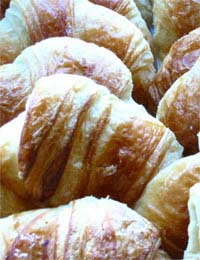All E Numbers Bad For You?

Q.
Are all E Numbers bad for children? It's just that my little boy sometimes has a really bad day at school and we're trying to find out if it's an E number that's causing it.
So far the linking factor is frozen croissants which have the following e numbers (E472e, E300 & E160a), would any of these affect his mood?
A.
Thanks for your question. It must be very frustrating trying to find the cause of your son’s bad days at school and it’s very possible that an E number may be at the heart of the problem.
To answer your first question, “Are all E numbers bad for children?” well, no, they’re not. E numbers generally get a lot of bad press, as people assume they’re all synthetic additives which can cause side-effects for children and adults. Whilst that’s certainly the case with some E numbers – and some more than others are known to cause problems – not all E numbers stem from synthetic or manmade origins and can be from natural sources too (interestingly, one of the E numbers you’ve pinpointed does come from a natural source). The difficulty for parents is of course knowing which are bad and which are less harmful, especially when manufacturers don’t always make it easy for consumers to find out what’s in their products.
It’s useful that you’ve managed to pinpoint a few E numbers that may be affecting your son. E472e is commonly used in croissants and other bakery products, as it acts as a dough conditioner, but it can also crop up in other products, such as gravy granules, hot chocolate and frozen pizza. It originates from tartaric acid (E334) and the esters of glycerol (E422). Generally speaking, it’s not one of the E numbers that is renowned for causing problems, although it is always possible, so this might not be the main culprit.
E300 is ascorbic acid or vitamin C and is one of the few E numbers that actually stems from natural sources. It’s used in products due to its antioxidant properties – it works in a similar way to preservatives and helps products stay fresh, last longer on the shelf and improve the look and taste of foods. It’s possible that a child could react to ascorbic acid, but it’s not one of the common E numbers that causes reactions when consumed in small doses, and not really with regards to behaviour.
As far as E160 goes, it’s a colour – and colours are often the source of some children’s behaviour issues. E160 is categorised from E160a to E160f, each with slight variations on the same ingredient. All of them, however, are used to add an orange, yellow or red colour to products. Originally, the primary source for E160 would have been natural, as the beta-carotene would have been gained from natural sources such as carrots or tomatoes; now, however, it is largely manufactured.
There aren’t major side-effects that have been noted to be linked to E160, although E160d has been banned in Australia and E160c is also avoided in several countries. Studies have found other colours are linked to hyperactivity and changes in children’s behaviour, so this may well be the source of your son’s problems.


Re: Dangers and Side Effects of E Numbers
Is this the tip of the iceberg? Can't help thinking we all being slowly poisoned by convenience food. Convenient for…
Re: E200 - E299 Preservatives
Hallo I need advise on what preservetives and ant foaming agents to use for lemon juice. Also reconmondations on how much powders to…
Re: Top E Numbers to Avoid
Since Brexit, I have been adding a few extra E numbers in my products and my sales have boomed! I now sell the tastiest burger in town. E…
Re: E Numbers Not Suitable for a Halal Diet
Is E202 is halal?
Re: Does E631 Use Extracted Pig's Fat or Sardine Oil?
400
Re: E Numbers Not Suitable for a Halal Diet
E140 is a plant product, not derived from meat at all. Please check your facts.
Re: Top E Numbers to Avoid
I was prescribed amitriptyline for anxiety and got on well with the first box of tablets. After starting the second box I began to feel…
Re: E400 - E499 Thickeners, Stabilisers and Emulsifiers
All thickener agent name All emulsifier agents name Cemical use Food use
Re: Top E Numbers to Avoid
You say that E133 is banned in Germany, yet my GP has prescribed Fultium-D/Colecalciferol 800 out capsules with E133 and the Manufacturer…
Re: Does E631 Use Extracted Pig's Fat or Sardine Oil?
In India, there is a law already existing, that any food products having any non-vegetarian ingredients…